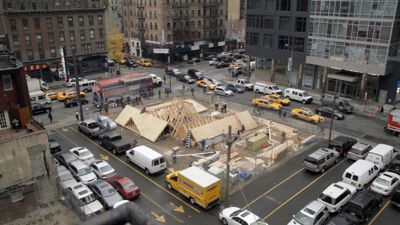One of my students read last week’s post and was interested in playing devil’s advocate by asking a few more questions about the recent New York Close Up segment, David Brooks Tears the Roof Off. Since some of the questions he brought up were similar to others discussed in the high school and graduate classes I teach, I asked if it was ok to share the questions with all of you and answer them as best I could in this week’s column. If you have anything to add, please feel free! Here goes….
Joe, couldn’t a creative roofer have completed the same project? Was an artist really necessary for a work like this?
First, very few roofers, even fancy ones, are being approached or directly involved with the Art Production Fund, who arranged for David Brooks to complete the project at this particular site- the last piece of empty, undeveloped space in Times Square. Works installed here, including a recent installation by Kiki Smith, have a connection to the surrounding area or make a connection in the work to the context itself. A “creative roofer” could not simply propose a similar project out of nowhere, and even if they did they wouldn’t be telling the same story or making the same associations, so it would be a completely different work even it looked exactly the same.
Wouldn’t a video feature like the one presented on New York Close Up have helped viewers enjoy the piece more? Why is so little information presented in spaces, especially galleries, featuring contemporary art?
More and more venues, particularly some of the larger museums such as Mass MoCA, offer plenty when it comes to giving viewers a narrative about what they are looking at. Sometimes it helps and sometimes it actually interferes by trying to dress up an otherwise lackluster work or exhibition. But the bottom line is that the artist and curator have to work out how much is going to be said (told?) up front and how much will be left for the viewer to surmise. I am sure David Brooks could have told his story from start to finish in a variety of ways for those passing by on the street, but that would be David telling viewers what the piece means to him and the associations he makes when he sees the completed work in context (because, as you know, David never saw the work complete until it was, well, complete. This is not a sculpture that was moved from another location. Rather, it was site-specific). David is interested in the connections and associations that viewers themselves make when seeing this installation. As an artist I too am more interested in what viewers bring to the work than whether I can tell the entire story for them.
What else do you think students can learn from a work such as this?
Aside from what’s already been suggested, some of the other things we can learn from David Brooks include:
Context makes a difference. If you take the same work of art and place it in three very different locations it will “read” differently. Obviously Brooks’ work in a “white cube” gallery wouldn’t have the same interaction with the surrounding space, population and architecture as it does in Times Square. It wouldn’t tell the same story or, literally, be framed the same way.
Contemporary art generates lots of questions. A large majority of the artists in the Art21 series make work that requires a level of viewer involvement – investigation, questioning, even research- in order to make sense of what’s being presented. Beauty may be in the eye of the beholder, but the beholder has work to do. Very rarely are we presented with work that is “only” about the physical material or the “only” about the image pictured. There are layers to the stories and that ‘s why these artists and their work make for good stories.
Finally… It takes a village. Brooks’ work required both artists and many other professionals with very particular skills in order to bring Desert Rooftops full circle. As we have seen many times with artists such as Mark Dion, Sarah Sze, Allan McCollum and Glenn Ligon, contemporary artists very often incorporate a variety of disciplines in order to realize their ideas.





